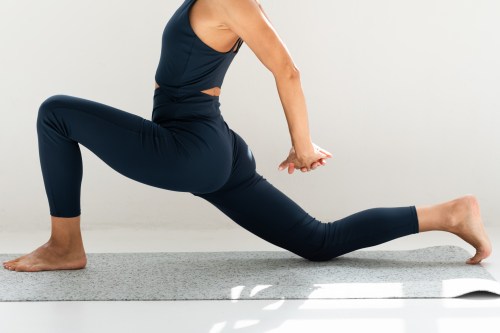When I read headlines about 80-year-old World Record-breaking runners, I can’t help but worry that I’ll be nowhere near as physically capable when I’m that age. I’m not even close to breaking records 50 years prior to being in my 80s, unless they’re for the most consecutive hours spent typing words onto websites. I guess I feel vaguely “in shape,” but I’m not even really sure what that means. Fortunately, though, “in shape” is definable, thanks to a concept known as the five components of fitness.
According to experts, what makes a robust fitness regimen consists of five different elements, which include cardiovascular endurance, muscular strength, muscular endurance, flexibility, and body composition. This gives your sweat routine a healthy mix of both aerobic and anaerobic exercise, mobility, and the ability to push yourself. That means that, unfortunately for myself, based on the criteria set out by this measurement, I probably need to get my butt into gear if I want to so much as walk fast in my geriatric years.
Below, Tony Carvajal, a CrossFit trainer with RSP Nutrition, explains all of the components of fitness that you need to know about, plus tips for improving your game in each area. Never was there a better argument for workout cycling than this back-to-basics approach to fitness.
For the most effective workout, be sure to hit the 5 components of fitness
1. Cardiovascular endurance
This element of a good workout routine is all about your heart. “Cardiovascular fitness is the ability of the heart and lungs to supply oxygen-rich blood to the working muscle tissues, and the ability of the muscles to use oxygen to produce energy for movement for a sustained duration,” Carvajal says. It’s pretty important when it comes to managing everyday activities, particularly from a longevity standpoint, even in a world where many of us have necessarily reduced the amount we physically exert ourselves (because computers). It’s also critical for having a heart that’s in tip-top shape.
You’ll notice that cardiovascular (or cardio) fitness machines tend to have their own section in the gym, filled with rows of treadmills and bikes and elliptical machines, all of which work to spike your heart rate. And the good news is that your cardio endurance is something that can be improved in a multitude of ways, according to Carvajal. “There are many different styles of cardiovascular training ranging from long distance running to metabolic conditioning—basically anything that will keep the body producing a high heart rate for a long period of time,” he says. “Pick the training that best fits you—[spinning, swimming, hiking, dancing, or just, you know, walking]—and constantly try increasing the duration time each training session at the same pace, slowly opening up the endurance threshold and strengthening the heart and lungs.”
2. Muscular strength
“Muscular strength refers to the amount of force a muscle can produce with a single maximal effort [example: one rep],” he says. “The size of your muscle fibers and the ability of nerves to activate muscle fibers are related to muscle strength.” Muscular strength is measured through power output, driving force, pulling load, and carrying heavy loads, Carvajal explains, and can be improved by lifting, pulling, pushing, and carrying heavy loads for shorter reps and shorter duration.
This is where bodyweight training or weight training come in. “The goal is to slowly lift heavier in small increments each session,” he says. Bad news for the girl who always picks the lightest weights in the room—aka me—if you’re trying to improve your muscular strength, you absolutely can lift too light; here, five reasons you should make yourself legit strength train even if you aren’t keen on it. And this is what to know about the three keys of good weight training.
3. Muscular endurance
Endurance is all about keeping your heart rate up for an extended amount of time at once. “Muscular endurance is the ability of muscle fibers to exert force and movement and remain active for a long period of time, as well as their ability to resist, withstand, recover from, and have immunity to trauma, wounds, or fatigue,” Carvajal explains. It can only be achieved muscle group by muscle group, meaning you might have high endurance capabilities in your core, but not so much in your calves or biceps.
That said, you can improve endurance in a particular muscle group by targeting it with light weights lifted at a higher rep count (like you might do in a Pop Physique class), engaging in body-weight-dependent exercises (aka exercises like plank pose), or repetitively pushing a bike pedal against resistance, and other such staple moves.
4. Flexibility
Flexibility is important in anyone’s fitness regimen, and is a key one of the components of fitness, as it has to do with the health of your joints. “Flexibility refers to the range of motion for a given joint,” he says. “The degree of flexibility that a person has is influenced by muscles and connective tissues, like ligaments and tendons.” And it’s more than about just touching your toes. Flexibility reduces your risk of injury, and is improved by (duh) constant stretching. “By regularly stretching, you will elongate muscles, ligaments, and joints and open up the body’s range of motion,” says Carvajal. Can’t touch your toes? Try these yoga stretches stat. Plus, if you’re looking for somewhere specific to start, this is the part of your body where flexibility matters most.
Try this yoga flow for better flexibility:
5. Body composition
“Body composition is used to describe the percentages of fat, bone, water and muscle in human bodies,” Carjaval explains. “Because muscular tissue takes up less space in the body than fat tissue, body composition, as well as weight, determines leanness which is a form of measurement to track fitness progression.” Body composition is improved by working on all of the above components of fitness. “If an athlete can consistently train these components, the body will react to the training,” says Carvajal. See? Easy as one, two, three, (four, five).
Not getting the results you want? These common mistakes may be sabotaging your workouts. Plus, here’s how to fake the Big Five personality trait that helps people reach their fitness goals.
Sign Up for Our Daily Newsletter
Get all the latest in wellness, trends, food, fitness, beauty, and more delivered right to your inbox.
Got it, you've been added to our email list.











